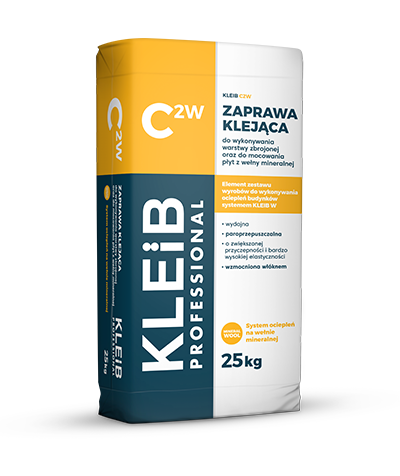ADHESIVE MORTAR
KLEIB C2W is part of the set of products used in the KLEIB W thermal insulation system for buildings.
KLEIB C2W is an adhesive cement mortar intended for attaching mineral wool panels and adding a reinforced layer in the KLEIB W thermal insulation system. It is suitable for attaching panels to mineral working surfaces such as concrete of all classes, cement and cement-lime plaster, surfaces consisting of masonry, ceramics, silicates, slag concrete, concrete aggregate and artificial stone, autoclaved aerated concrete and natural stone masonry.
- high yield
- vapour permeable
- fibre reinforced
- increased adhesion and very high degree of flexibility

25 kg
54
to form a reinforced layer, approx. 5.5-6.5 kg/m² for bonding mineral wool panel, approx. 4.5-6.5 kg/m²
CALCULATE CONSUMPTIONKLEIB C2W is an adhesive cement mortar intended for attaching mineral wool panels and adding a reinforced layer in the KLEIB W thermal insulation system. It is suitable for attaching panels to mineral working surfaces such as concrete of all classes, cement and cement-lime plaster, surfaces consisting of masonry, ceramics, silicates, slag concrete, concrete aggregate and artificial stone, autoclaved aerated concrete and natural stone masonry
The working surface should be stable, even and structurally sound i.e. strong enough, and free from any layers that might weaken the mortar’s adhesion, in particular dust, dirt, lime, oil, grease, wax, or remains of emulsion and oil paint. Prior to commencing work, the surface should be cleaned and primed where it is too absorbent. Priming is also required where the working surfaces are for instance weaker cement and cement-lime, as well as walls made of cellular concrete elements or breeze blocks. For this works KLEIB G1 primer should be applied. Larger irregularities, unevenness and cavities should be filled using an appropriate mortar. In the event of doubt as to structural soundness, a prior adhesion test is recommended. When using this mortar to form a reinforced layer, the surface of the mineral wool panels should be even, clean and stable.
The mortar is prepared by pouring the entire contents of the bag into a container with a measured amount of water and mixing until a smooth, lump-free uniform consistency is obtained. The mortar is ready to use after 5 minutes and after remixing. Prepare portions that are to be used within approx. 2 hours.
For bonding mineral wool panels on even working surfaces, it is advisable to apply the mortar on the entire surface of the insulation panels and spread it with a notched plasterer’s float. In case of an uneven working surface, the mortar should be applied to the panel in the form of thick layers along its edges, at the distance of approx. 3 cm from the edge, along with 6 to 8 patches of mortar uniformly distributed on the rest of the panel’s surface. As a result, a min. 60% of the panel’s surface must be sufficiently adhered to the working surface. Panels should be tightly placed side by side starting from the base of the façade – from the starter strip. Vertical joining of panels should maintain a staggered arrangement. Panels should be applied so as to form a flat surface. Further work, i.e. any use of suitable mechanical fasteners (according to the technical design), or the forming of a reinforced layer, can be performed no earlier than 72 hours after the insulation is applied (depending on humidity and temperature conditions). In order to lay a reinforcing layer on the surface of adhered mineral wool panels, one should spread a thin layer of KLEIB C2W mortar, and then following the initial bonding, apply another layer to a thickness of approx. 3 mm, spreading this with a notched plasterer’s float and embedding a reinforcing mesh of fibreglass in this layer. The surface should be levelled and smoothed with another layer of mortar so that the mesh is completely invisible. Mesh strips should be joined to each other by means of a min. 10 cm wide overlap. Avoid working in direct sunlight, rain or strong winds. The use of protective nets on scaffolding is recommended. Priming of a reinforced layer with a suitable primer can begin no earlier than after 72 hours.
Approx. 5.5-6.5 kg/m2 for forming a reinforced layer. Approx. 4.5-6.5 kg/m2 for attaching sheets
The mortar must be transported and stored in tightly sealed bags, in dry conditions. Protect from dampness. Shelf life in conditions that comply with the specified requirements is 12 months from the production date on the packaging.
